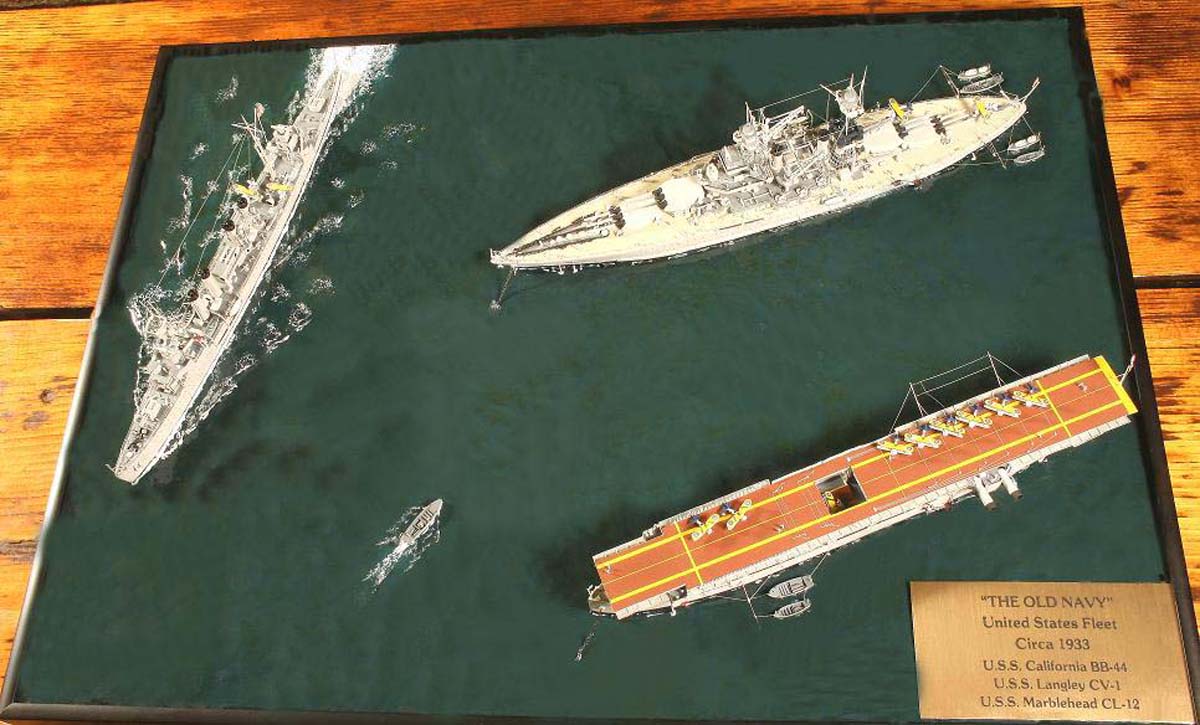by John Leyland

1/700 USS Langley CV-1 (scratchbuilt)
"The Old Navy" Part 1
USS Langley

"The Old Navy" Part 1
USS Langley
This diorama depicts three warships of the US Navy lying in an anchorage during the late 1920's. The scene could be of Lahaina in Hawaii, the Panama Canal Zone, or off Long Beach, California. As I continued with my series of one carrier from each decade of naval aviation, I decided to build USS Langley to represent the decade of the Nineteen Twenties. The US Navy, after an early lead with the first launching and landing of an aircraft on a ship, had fallen behind in aviation technology. During and after WWI, the Royal Navy had gained considerable experience with a number of aviation ships, including the conversion of the battle cruiser HMS Furious and the full deck carrier Argus in 1918. The Imperial Japanese Navy had begun construction of the first "keel -up" aircraft carrier Hosho in December, 1919. In March, 1922 the USS Jupiter, a former collier, finished her conversion as the US Navy's first aircraft carrier and was commissioned USS Langley. With a top speed of fifteen knots, she was not even fast enough to keep up with the battle line, but she became the laboratory in which the pionering naval aviators experimented with arresting gear and catapults, worked out deck cycles and strike tactics, and generally advanced personal and corporate experience in operating aircraft at sea. The carrier admirals and squadron commanders of WWII learned their trade aboard the "Covered Wagon".
Langley was my first attempt at a scratchbuilt ship. Plans were hard to come by in the 1970s. My main reference was an enlargement of a small drawing in Terzibaschitsch "Aircraft Carriers of the US Navy". Photos from Pawlowsky's "Flattops and Fledglings" and an excellent series of Jupiter under conversion before the flight deck was added clipped from US Naval Institute "Proceedings" were all I could find. Since the limiting factor in the project was my ability to construct the girders, this was the first part to be attempted. A wooden jig was built to hold the spacing of two vertical strips while stretched sprue crosspieces were attached. When two girder sides were completed, they were set on edge in the jig as the third and forth sides wre completed. I was pleasantly surprised at how quickly this assembly line produced the girders. The hull was built using the "eggcrate method" well known to builders of wooden models. The waterline shape, main deck shape, longitudinal and cross members were cut from .020 Squadron sheet. The sides were planked with .010 sheet for three-quarters of the length where the sides were flat. The graceful compound curves of the stern were filled with two part plumber's epoxy putty. Photos clearly showed the lines of rivited plating in the hull. These were suggested by placing strips of masking tape on the hull and filling between them with several coats of paint. The resulting raised areas which were visible only with correct lighting replicated the effect of the photos quite satisfactorily. The bridge and deckhouse structure supported two .030 square beams which set a level for the flight deck under which the girders and their connecting structure could be aligned. The flight deck was cut from N gauge boxcar siding and the underside was strengthened with brass tubing along each side to prevent warping. These were hidden by sliding inside the two main support rails already mentioned. The bottom of the flight deck was detailed with cross girders and the two traveling cranes which moved aircraft on the hangar deck. The elevator on Langley did not lowere flush with the hangar deck. Aircraft were moved from the elevator by the cranes, or after having their wings removed, lowered into the former coal holds. Railings and ladders were done with sprue. Aircraft were scratchbuilt. Crewmen were formed from wire armatures filled out with "green stuff" (no commertial photoetch was available yet).
When the model was completed and mounted on a base, I was disappouinted in it's diminutive size. It didn't seem impressive enough for the work expended. I had long considered building a cage mast battleship, so a three ship diorama of my favorite period of naval history offered a solution. I'll leave that for Part 2.
